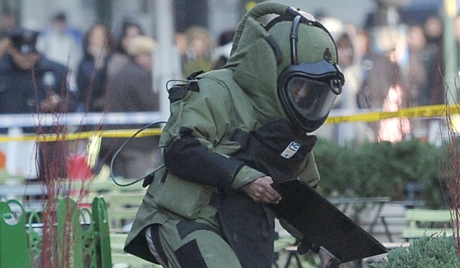
Twenty Years On, Ossetian-Ingush Conflict Still Far from Being Resolved
Publication: Eurasia Daily Monitor Volume: 9 Issue: 204
By:

On October 23, a suspected suicide bomber destroyed a police checkpoint on the administrative border between Ingushetia and North Ossetia. One police officer died in the attack and several others were injured. The power of the bomb was estimated at 50 kilograms of TNT. The suspected attacker arrived at the North Ossetian police checkpoint from the Ingush side, so the attack sparked another round of mutual accusations between ethnic Ingush and Ossetians. Following the attack, the head of Ingushetia, Yunus-Bek Yevkurov, stated that the attack was carried out in the run-up to the 20th anniversary of the Ossetian-Ingush conflict and was designed to undermine “positive changes in Ossetian-Ingush relations that had occurred recently.” Besides overlapping with the 20th anniversary of the start of the brief Ossetian-Ingush conflict at the end of October 1992, the bombing also coincided with the anniversary of the rebel raid on the Dubrovka theater in Moscow on October 24, 2002 (https://ria.ru/crime/20121023/905803901.html).
Adam Ekazhev, a 24-year-old resident of the village of Ekazhevo in Ingushetia, was identified as the perpetrator of the attack on the police checkpoint. Ekazhev had been thought to have gone missing in May 2012 (https://ria.ru/investigation/20121024/906166167.html). Shortly after the perpetrator of the attack was identified, the Federal Security Service (FSB) announced that they had found an Improvised Explosive Device (IED) with the explosive power of 15 kilograms of TNT in the house of Ekazhev’s parents, where he lived. The FSB claimed that since defusing the device was dangerous, it was detonated in a controlled explosion, which destroyed the house. Many people in Ingushetia believe that the regular discovery of IEDs in rebels’ houses is in fact a form of collective punishment. In the case with Ekazhev, they ask: if he was a suicide bomber, as the authorities claim, why would he hide another IED in his parents’ house? (https://ingushetiyaru.org/news/35689/).
The head of North Ossetia, Taimuraz Mamsurov, suggested the suicide bomber was planning an attack in the capital of the republic, Vladikavkaz, targeting civilians (https://ria.ru/crime/20121023/905926325.html). If civilians were attacked in North Ossetia, it would be the first attack on civilians by the insurgency since Caucasus Emirate leader Doku Umarov announced a halt to attacks on civilians at the beginning of 2012. So far, it looks more like the insurgents specifically targeted the police checkpoint. Even if they had passed through it, they might have attacked non-civilian targets elsewhere. At this point it is not possible to conclude whether the insurgents’ moratorium on attacks targeting civilians has ended.
On October 29, Yevkurov stated at a press conference in Moscow that the newly appointed leader of the insurgency in Ingushetia, Amir Mutaliev, was responsible for the attack. He claimed two people were arrested in connection to the attack and were providing testimony to the police (https://ria.ru/incidents/20121029/907759843.html).
The attack revived mutual suspicions between ethnic Ingush and Ossetians who live in the region, especially since it coincided with the anniversary of the 1992 conflict. Back then, in a matter of several days, tens of thousands of people were displaced and hundreds of people died in what became known as the Ossetian-Ingush conflict. The conflict was caused by a dispute over an area in North Ossetia that borders Ingushetia. Although Moscow’s official position is that the Ossetian-Ingush conflict has been resolved, there are still refugees, specifically Ingush refugees, who have not returned to their former residences. Relations between ethnic Ossetians and Ingush tend to be tense and at times even conflict-prone when incidents take place.
On October 21, a group of ethnic Ingush clashed with an Ossetian police patrol in the village of Dachnoe, which is in North Ossetia but whose population is predominantly ethnic Ingush. According to the Ingush opposition website Ingushetiyaru.org, several ethnic Ingush residents of Dachnoe were treated for injuries they received in the clashes (https://ingushetiyaru.org/news/35677/). The North Ossetian police reported that when road police stopped a drunk Ingush driver, local Ingush residents became involved, snatching the driver and fleeing into Ingushetia (https://www.newsru.com/russia/22oct2012/os.html). Whatever the reality was on the ground, the incident demonstrates the level of distrust between the North Ossetian authorities and the local ethnic Ingush residents, which periodically manifests itself in violent incidents.
In the modern globalized world, it should come as no surprise to anyone that Ingush and Ossetian intellectuals use Samuel Huntington’s theory about the “Clash of Civilizations” in their discourse. So Ossetians argue that the Ossetians and Ingush are divided by hardwired civilizational differences that supposedly prevent them from living side by side peacefully (https://ingushetiyaru.org/news/35744/). It is noteworthy that Samuel Huntington indeed cited the Ossetian-Ingush conflict of 1992 as an example of conflicts between Christian and Islamic civilizations (Foreign Affairs, “The Clash of Civilizations?” Summer 1993). Yet, Huntington certainly missed the intricacies of the conflict in 1992. For example, much of the available evidence points to the decisive role played by Moscow in paving the way for the Ossetian-Ingush clashes and ultimately benefitting from the conflict.
Twenty years since the brief-but-bloody Ossetian-Ingush conflict, the frictions between the two groups remain surprisingly strong. Part of the problem is that in the absence of democratically elected institutions, both sides are practically deprived of a chance to subscribe to an agreement that they would wholeheartedly agree to. Moscow, in its turn, does not seem to be overly interested in establishing a long-lasting peace in the area. Moscow’s reluctance is partly linked to its political interests in the North Caucasus, which are still informed by the policy of divide et impera. But another part of the issue is that Moscow may simply have no prior knowledge of how to solve such conflicts in the absence of a totalitarian political system. Meanwhile, the Ossetian-Ingush conflict remains one of the potential hot spots in the North Caucasus that could explode as soon as the Russian government weakens its control over the area and/or again decides to exploit the conflict for its own purposes.




